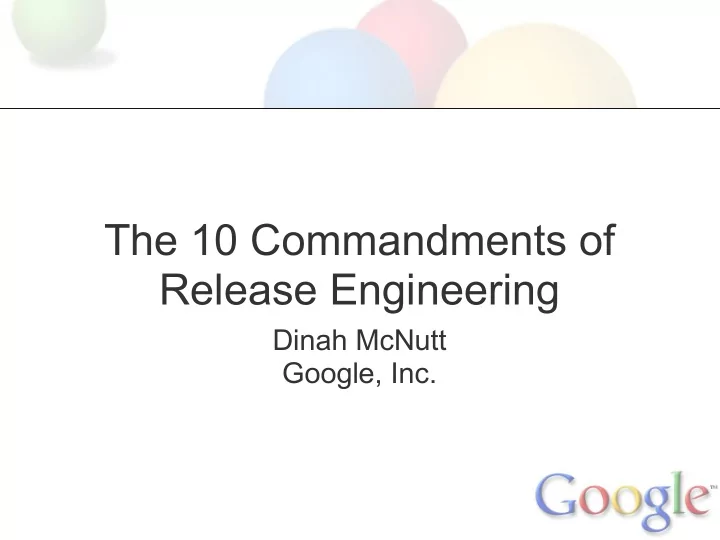

The 10 Commandments of Release Engineering Dinah McNutt Google, Inc.
Overview This talk is really about "Build & Release", not just "Release" Focus is on server-side software The commandments are solutions to requirements Ideas apply to software products for both internal and external customers Ideas presented are my own, not necessarily Google's
Background Release processes are usually an afterthought Most build systems do the minimum required to "get it done" Release processes should be treated as products in their own right There is often a big disjoint between the developer writing the code and the system admin who installs it
Build & Release Steps Check out the code from the source code repository Compile and/or process the code Package the results Analyze the results of each step and report accordingly Perform post-build tests based on the results of the analysis step
Build & Release Process Features Repeatable Tracking of changes and the ability to understand what is in a new version of the product or product component An identification mechanism (e.g. build ID) that uniquely identifies what is contained in a package or product Implementation and enforcement of policy and procedures Management of upgrades and patch releases
I - Thou shalt use a source code control system. Everything needed to build should be under source control source code build files build tools Repeatability is a virtue.
Reproducible Build Environment Operating System Compilers Build tools
II - Thou shalt use the right tool(s) for the job. Complex projects may require multiple build tools Examples: make for C and C++ - the dependency checking is crucial ant for java scripting languages (bash, python, etc.) Unnecessary complexity is a sin.
III - Thou shalt write portable and low- maintenance build files Plan to support multiple architectures and OS versions Use centralized Makefiles for definitions common to Makefiles Compiler options will change between architectures Editing hundreds of files for a single change is no fun Provide template files so developers can easily create new build files
IV - Thou shalt use a build process that is repeatable And automated... And unattended... And repeatable... Identify your customers: QA Developers Management External customers Leverage open source tools like Hudson and Cruise Control Adopt a continuous build policy
V - Thou shalt use a unique build ID Generated at build time Should provide enough information so the build can be uniquely identified and reproduced Examples: Date Repository revision Release version Should be easily obtainable Included in packaging Embedded in binaries
VI - Thou shalt use a package manager Auditing Installation/upgrade/removal Package summary (who, what, when, etc.) Manifest (ok, tar -tf gives you that.) Can leverage installation/upgrade/removal capabilities Built-in version tracking tar is not a package manager...
VII - Thou shalt design an upgrade process before releasing version 1.0 Packaging decisions can affect the ability to upgrade
VIII - Thou shalt provide a detailed log of what thou hath done to my machine Installing/Patching/Upgrading/Removing the software should provide a detailed log of what is happening Ideally there should be a "do nothing" option so I can see what is going to happen first
IX - Thou shalt provide a complete install/upgrade/patch/uninstall process
X - System Admin: Thou shalt apply these laws to thyself All of these commandments can be applied to system customizations
Recommend
More recommend